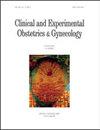胎盘综合征中人脐带间充质干细胞保守的干细胞/基质表型增殖潜能降低:一项前瞻性队列研究
IF 0.6
4区 医学
Q4 OBSTETRICS & GYNECOLOGY
引用次数: 0
摘要
背景:胎盘综合征的病理生理学尚不清楚,脐带源性间充质干细胞(UC-MSCs)可能在这些综合征的发展中发挥作用。在这项前瞻性队列研究中,我们评估了两种类型的ucmscs, Wharton’s Jelly MSCs (WJ-MSCs)和脐带血MSCs (CB-MSCs)在胎盘综合征中的增殖能力。方法:将16份脐带血和脐带样本进行种子培养,直至骨髓间充质干细胞生长潜能耗尽。累积群体加倍用于研究生长潜力,流式细胞术免疫表型用于验证间充质标记物。结果:在我们的前瞻性队列研究中,病理妊娠的CB-MSCs一方面表现出生长潜能的显著降低,另一方面WJ-MSCs表现出更高的生长潜能的趋势。这一趋势与众所周知的WJ-MSCs在低氧环境下的快速生长表型相一致。此外,众所周知,慢性缺氧是宫内生长受限(IUGR)和子痫前期的主要特征,因此,我们的数据与众所周知的临床特征完全吻合。结论:与健康妊娠获得的间充质干细胞相比,胎盘综合征获得的CB-MSCs的生长潜力有降低的趋势。我们的结果需要在更大规模的体外研究中得到证实,因为更高数量的CB-和WJ-MSC将更好地阐明胎盘综合征的病理生理。本文章由计算机程序翻译,如有差异,请以英文原文为准。
Reduced Proliferative Potential with Conserved Stem/Stromal Phenotype of Human Umbilical Cord Mesenchymal Stem Cells in Placental Syndromes: A Prospective Cohort Study
Background: Pathophysiology of placental syndromes is still unclear, and umbilical cord-derived mesenchymal stem cells (UC-MSCs) might play a role in the development of these syndromes. In this prospective cohort study, we evaluated proliferative abilities of two types of UC-MSCs, Wharton’s Jelly MSCs (WJ-MSCs) and cord blood MSCs (CB-MSCs), in placental syndromes. Methods: A total of 16 cord blood and umbilical cord samples were seeded and cultured until MSC growth potential exhaustion. Cumulative population doublings were employed for studying growth potential, and flow cytometry immunophenotyping for verification of mesenchymal markers. Results: In our prospective cohort study, on one hand CB-MSCs from pathological pregnancies showed a significant reduction of growth potential, on the other hand WJ-MSCs showed a trend toward higher growth potential. This trend is consistent with the well-known faster-growing phenotype of WJ-MSCs under low oxygen atmosphere. Moreover, it’s well understood that chronic hypoxia is a main feature of both intrauterine growth restriction (IUGR) and preeclampsia, thus, our data perfectly match with the well-known clinical characteristics. Conclusions: Growth potential of CB-MSCs obtained from placental syndromes tended to be reduced compared to that of MSCs from healthy pregnancies. Our results need to be confirmed in larger in vitro studies, as a higher number of CB- and WJ-MSC would better clarify pathophysiology of placental syndromes.
求助全文
通过发布文献求助,成功后即可免费获取论文全文。
去求助
来源期刊
CiteScore
0.50
自引率
0.00%
发文量
241
审稿时长
1 months
期刊介绍:
CEOG is an international, peer-reviewed, open access journal. CEOG covers all aspects of Obstetrics and Gynecology, including obstetrics, prenatal diagnosis, maternal-fetal medicine, perinatology, general gynecology, gynecologic oncology, uro-gynecology, reproductive medicine, infertility, reproductive endocrinology, sexual medicine. All submissions of cutting-edge advances of medical research in the area of women''s health worldwide are encouraged.

 求助内容:
求助内容: 应助结果提醒方式:
应助结果提醒方式:


